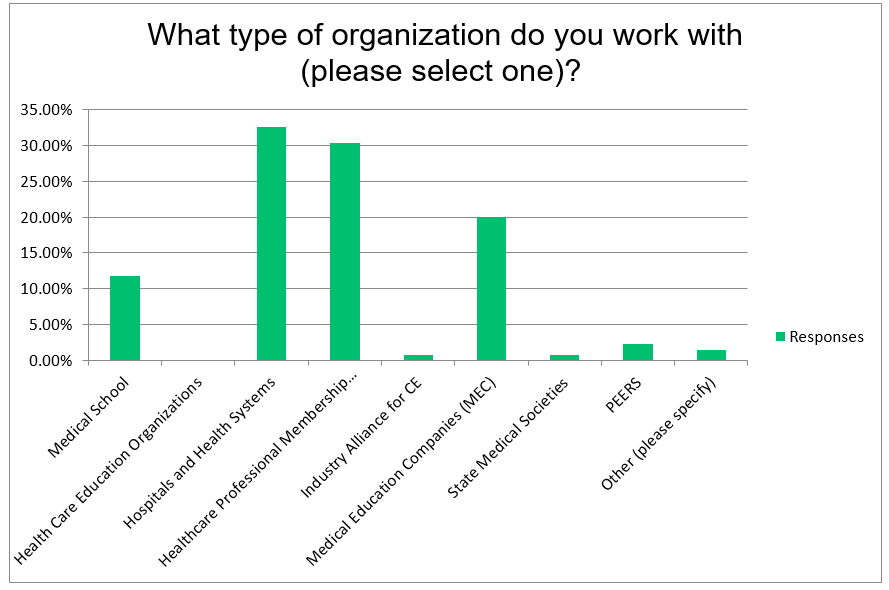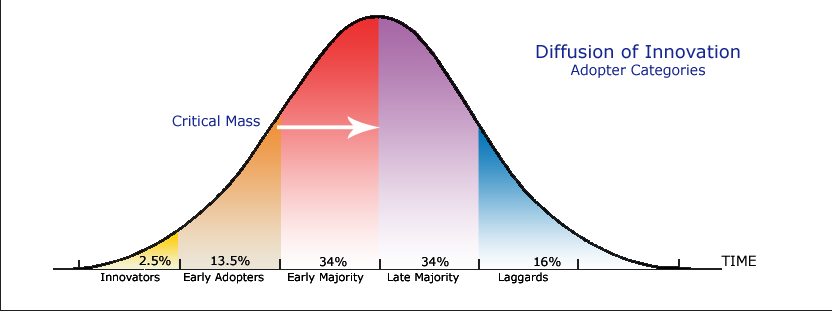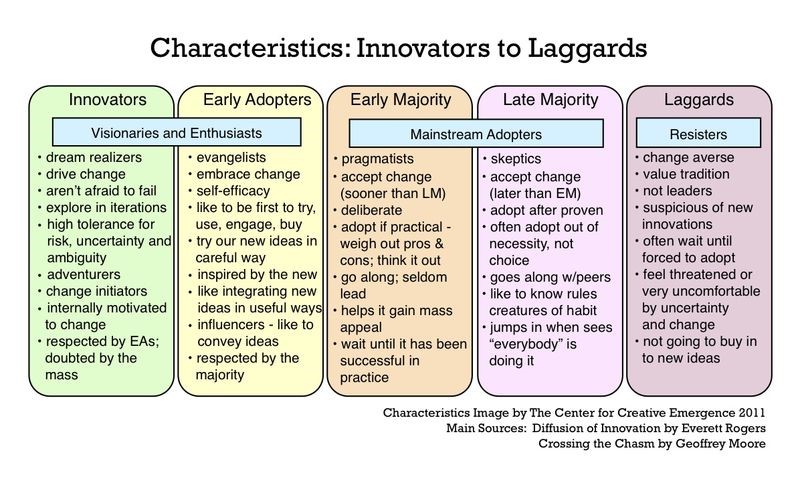Introduction
In December 2020, the ACCME released the new Standards for Integrity and Independence in Accredited Continuing Education as a replacement for the previous Standards for Commercial Support. The ACCME also announced that providers needed to adopt and implement the new standards no later than Jan. 1, 2022. Throughout 2021, the authors of this paper discussed this change process with numerous colleagues and were struck by the many different approaches and opinions. Thus, we developed a survey to assess providers' status and attitudes toward the new standards. We collected responses from the ACCME community between Oct. 20 and Nov. 15, 2021. Survey responses were solicited in multiple ways: emails directly to colleagues, requests sent via the Alliance listservs, emails by the Alliance staff to people who attended a webinar focused on the new standards, as well as posts on social media (LinkedIn and Twitter).
We received 135 responses. Sixty-five percent of respondents identified as a manager or director of education with the rest falling into various categories including vice president, coordinator, CEO/president and other. The responses were diverse in provider types:

The respondents indicated strong confidence in their ability to implement the new standards. On average, respondents indicated they have implemented about 70% of the new standards, with 18.5% of respondents indicating they had already implemented 100% of the new standards. However, the respondents were split on how difficult the new standards were to implement; given a range of 1 to 100 with 1 being easy and 100 being very difficult, the average was 51.
When asked which element of the new standards was most difficult for the respondent, the top answer was, “Determining which financial relationships are relevant to the content of the continuing education activity.”
When asked what opportunities the implementation of the new standards had provided to them or their organization, 85% indicated they had revamped their disclosure policies, 73% had brushed up on skills related to the topic, and 49% had engaged with stakeholders to discuss the topic.
Our Survey Data Through the Lens of Rogers’ Diffusion of Innovation Theory
Rogers’ Diffusion and Innovation Theory gives insights into how communities, such as the continuing healthcare education community, adopt change. In particular, how is the community adopting the Standards for Integrity and Independence? The data generated from the 2021 survey of the Alliance community shows that we are clearly following the bell curve of Rogers’ Theory. Communication and peer networking are important in the change process. Over time, the new idea — in this case the Standards for Integrity and Independence — becomes diffused among the population until a point of saturation is achieved. The theory uses a bell curve with five categories of adopters: innovators, early adopters, early majority, late majority and laggards.
The survey data shows that in November 2021, slightly more than 50% of the survey respondents self-assessed their adoption of the Standards for Integrity and Independence to be complete or nearly complete. At the time of this survey, our respondents slightly exceeded the critical mass measurement of adoption on the bell curve.

The five categories of adopters are evident in the survey responses. The chart below shows characteristics of each group of adopters.

Comments on the survey follow the five categories of adopters. Innovators and early adopters are visionaries and enthusiasts. Slightly more than half of the survey respondents thought that the standards were easy, and those responders indicated an average of 89% implemented. Some of the comments from the group who found the standards easy to implement include:
- Stakeholders have adapted easily to the new standards because of frequent education on this topic.
- Most of the new criteria are the same or practices that we were already implementing to ensure that we were the "final arbiter" of the integrity of the content.
- I think ACCME has done a wonderful job in providing a resources site as well as FAQ and checklist documents for providers to include with these new policies. It's very helpful when most of that work is done for you.
- Thank you for the simplicity of the new standards.
- This hasn't been a big deal.
The late majority are skeptics who often adopt change out of necessity not choice. The laggards group are resisters to change who often wait until they are forced to change. Comments from people who think implementation of the standards is hard (slightly less than 50% of respondents), but they are more than 70% implemented:
- For something that is supposed to make life a bit easier, it sure got harder.
Examining survey data of those who indicated they are less than 25% complete in implementing the Standards for Integrity and Independence reveled the following skepticism and resistance:
- We have not implemented the new standards. We are listening to issues and questions others are having when they have implemented the new standards. We are concerned how this change will go.
- Change altogether is difficult for my leadership.
Not surprisingly, our community of educators is showing similarities with other groups adopting change. With the ACCME and Joint Accreditation Jan. 1, 2022 deadline now past, it would be interesting to see how long it takes for the late majority and laggards to fully implement the standards. That may depend on factors such as the types of accreditation they hold (for example, the ANCC deadline for full implementation is not until July 1, 2022), or timing of their next accreditation cycle.
Hospitals and Health Systems
Hospitals and health systems represent 44% of the survey respondents. An overwhelming majority of those completing the survey were either directors, managers or coordinators of education at their respective organizations. The majority (70%) indicated that they offered education to a wide variety of specialties and professions, with physicians being the largest audience. That would suggest that the Jan. 1, 2022, ACCME and Joint Accreditation compliance deadline was a major driving force in timing of implementation. At the time of this survey, most of the respondents were three-quarters of the way into their implementation of the new standards (72%).
When it comes to the implementation of the different elements of the new standards, respondents from hospitals and health systems have vast differences in opinion. However, these providers generally found two elements of the standards to be easier to implement:
- The new requirement that faculty may not actively promote or sell products or services that serve their professional or financial interests (55%)
- The new requirement that organizations may not share the names or contact information of learners with any ineligible company or its agents without the explicit consent of the individual learner (72%)
On the flip side, more than 50% of the respondents indicated that it will be difficult/very difficult to determine which financial relationships are relevant to the content of the continuing education activity.
Within the survey, respondents who were having difficulty with implementing the standards had an opportunity to provide more insight into what was causing the difficulties. For hospitals and health systems, there was a consistent theme in the comments about an additional demand on staff time to make these changes and train faculty on the new processes and policies. In addition, several respondents noted that determining relevance and selecting the best mitigation strategies also were challenging.
The survey also gathered data on the different hospitals and health systems stakeholders that have been involved in the implementation of the new standards. Respondents indicated that their stakeholders include their CME and IPCE committees, organization leadership, conference and RSS course directors, division chiefs, department chairs, program directors, RSS coordinators and faculty.
Respondents were able to indicate their perceptions of impact of implementing certain elements of the new standards on their stakeholders. There was very little consistency/pattern to the responses. However, there were two areas where the majority of respondents agreed the new standards were impacting their stakeholders:
- 56% of the respondents indicated that it was very easy/not much different for their stakeholders to only disclose relevant financial relationships to learners prior to the activity
- 63% indicated that the new requirement that organizations may not share the names or contact information of learners with any ineligible company or its agents without the explicit consent of the individual learner also was very easy/not much different in terms of implementation for their stakeholders
Respondents were also able to note areas that were the hardest for their stakeholders with regards to the new standards and why. Many noted that the new terminology/jargon (“mitigate” and “ineligible company”) presents challenges for their stakeholders. In addition, having to explain to some planners, faculty and speakers that they may no longer participate in accredited education, due to the expanded definition of ineligible company, presents its own unique challenges.
At the end of the survey, respondents were able to share additional comments. These comments really illustrated how different every organization is and how the implementation appears to vary. Several organizations thanked the ACCME for the simplicity of the new standards and the toolkit, while others noted that new implementation process has been a burden and that the new standards lead to more ambiguity and subjectivity. If a follow-up survey was done for this section, it would be useful to gather additional information from respondents on their organization/department size and the overall volume of activities managed. One might conclude that these play a factor in the overall variations seen in the survey responses.
Healthcare Professional Membership Societies
Of the responses received, 41 (30%) came in from healthcare professional membership societies (HPMS), which was the second highest response rate behind hospitals and health systems. Over 81% of the respondents in this group are either directors (54%) or managers (27%) of education.
Of this group, 63% say they are 70% or more complete in implementing the new standards. In total, 49% indicated they are 90–100% complete in their implementation. Less than 1% indicated that they have not started the process or are less than 10% along in their process.
The HPMS respondents are mixed in their thoughts about how difficult the new standards are to implement. There was equal distribution between those who thought the new standards were easy, neutral and difficult.
In general, the HPMS group agrees that it will be easy to implement the following:
- Changing to the new term of “ineligible company” from “commercial interest”
- Obtaining disclosure of all financial relationships
- Collecting data for 24 months
Determining the relevancy of a financial relationship to the content of an activity is the most difficult for this group to implement. Now that all financial relationships are required to be disclosed to the provider rather than only those that are determined relevant by the person disclosing, the responsibility of determining relevancy has shifted to the provider. The respondents indicated that this can consume large amounts of staff and stakeholder time and yet recognized that this is critical to compliance. One respondent stated, “This is a very TIME-CONSUMING PROCESS now. The expectation to remove disclosures that are not relevant is extremely tedious.” Some societies are dealing with a reduced staff, which makes this process even more burdensome.
When asked about the difficulty of implementing the new standards, another respondent indicated the hardest part of the standards to implement was, “Making a final determination if a company is ineligible. There are so many grey areas and blurred lines with some companies.” This sentiment was noted by many HMPS respondents.
For societies, many faculty who have the most experience also are those who have relationships with ineligible companies. Most relationships can be mitigated. However, the ownership relationship causes disqualification for faculty in most cases. When asked about what difficulties they are facing, one respondent stated they were getting “physician push back on the new definition of ‘owner’ to include all equity in privately held companies.” In addition, another response brought up the following point: “I wish the ACCME had shared evidence that backed up the decision to include owners of equity in privately held companies into the ‘unresolvable conflict’ category.”
Medical Schools
Approximately 12% of the survey respondents were in the medical school member section. Nearly 37% of the respondents were at a director level, 25% coordinators, 19% managers and 19% other. Implementation of the standards is going well for this member section. Eighty-seven percent say they are nearly complete with implementation. Thirteen percent had barely started with implementation. Medical school respondents indicated that half are finding the implementation easy, while 22% are finding it moderately hard and 27% are finding it very hard to implement.
The medical school member section found the following items to be very easy to implement (shown in order of their ranking, with least difficult at the top):
- Organizations may not share the names of learners without explicit consent
- Only disclosing relevant financial relationships to the learner prior to the activity
- Requirement to disclose all financial relationships
- Requirements that faculty may not promote or sell products
- New terminology “ineligible company”
- 30 minutes between accredited education and non-accredited activities
When asked to identify the most difficult, the medical school member section identified:
- Determining which financial relationships are relevant to the content
- Only disclosing relevant financial relationships to the learner prior to the activity
- New terminology “ineligible company”
When asked to elaborate on the difficulties they are experiencing, several respondents said that their learning management system (LMS) was not able to manage the new information. They are finding it challenging to adapt their LMS and workflow systems to the new standards. Also, making new habits with joint providers and faculty is taking time, and some had received push back and resistance. Another respondent said they are constantly stuck on owner/employee issues.
A broad range of stakeholders and staff are involved in implementing or complying with the new standards, from RSS coordinators to CE committee, faculty/presenters, legal affairs, web and IT services and executive management of the school of medicine. One third of the respondents said that stakeholders are finding the new terminology to be difficult, if not incomprehensible. One respondent stated, “The term ‘ineligible company’ is awkward at best, but confusing to almost everyone.” Another stated, “Our faculty are confused by the term ‘ineligible company.’ They seemed to understand ‘commercial interest,’ but we are getting a lot of questions from faculty asking what an ineligible company is.”
Medical Education Companies
Approximately 20% of the respondents to the survey were from medical education companies (MECs), with most identifying as managers (20%), directors (23%) or vice presidents (26%) of education. On average, the respondents in this category indicated they were 82% complete with implementation. Respondents in the MEC category, when asked how easy or hard it was to implement the new standards overall, fell right in the middle of the rating scale, with 29% finding it easy and 26% finding the implementation very difficult, with the rest right in the middle.
MEC respondents thought the following requirements were fairly easy to implement (shown in order of their ranking, with least difficult at the top):
- Faculty may not actively promote or sell products or services that serve their professional or financial interests
- Collect financial relationships from the previous 24 months
- Organizations may not share the names or contact information of learners with any ineligible company or its agents without the explicit consent of the individual learner
MEC respondents found most difficult the requirement that they determine which financial relationships are relevant to the content of the continuing education activity, followed by the new definition of "owner" to include equity in privately held companies. One individual stated, “This [the new standards] has disproportionately higher impact and expense for smaller meeting/providers, without clear benefit to the CME.” Another commented, “No real difficulties other than getting the team educated and systems updated (finding time to do so).”
MEC respondents felt that the same aspects of the new standards were the most difficult for their stakeholders (determining which financial relationships were relevant and using the new definition of “owner”). One stated that their stakeholders were struggling with “correctly asking about ownerships (stock vs. stock options) and private vs. public.”
The two free responses received at the end of the survey from this category were symbolic of the attitudes we saw throughout the survey:
- With staff and volunteers having to deal with all the financial problems associated with COVID: implementation and education of this new system is a total disaster … It just seems so complicated for no reason … very frustrating!
- I'm grateful for the ACCME's toolkit and expansive FAQs and hope they will continue to expand with specific scenarios!
Conclusion
The goal of this survey was to take the temperature of the Alliance community regarding the implementation of the new Standards for Integrity and Independence. The survey results indicate that most have taken a pragmatic approach to this process. There are some laggards, as is to be expected, but most of the respondents had taken some steps toward implementation. There are a number of critiques of the new standards as well as those who praise the change. As we know from Rogers’ Theory described above, communication and peer networking are important in the change process. As a community, it is now our responsibility to develop best practices and disseminate these widely so that we can help our colleagues adhere to the ACCME and other accreditors’ expectations. Ultimately, it is our shared responsibility to ensure accredited educational programs are developed from a place of integrity and independence.
Do you want more education on the new Standards for Integrity and Independence? Do you want an online strategy sharing session (casual conversation) or something more formal? What specific areas would interest you? Do you have implementation success stories to share? Please email the Almanac editor at almanac@acehp.org, who will share your thoughts and feedback with the authors.
Acknowledgements: Thanks to the 135 individuals who responded to this survey and the Alliance staff for help distributing the survey.